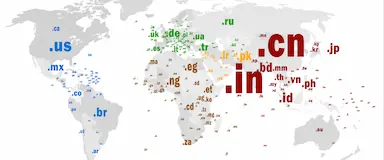With generic TLDs being oversaturated and marketed globally, country domains can help you reach a local audience and boost SEO.
.am TLD Turns 30 and Seeks a Broader Audience
Written by Sarah Johnson ·

There are over 300 country-code top-level domains, or ccTLDs, out there. Popular and well-known examples include .fr for France, .ru for Russia, and .au for Australia. One you might not have heard of is .am, but that could be about to change, as this ccTLD seeks new and exciting opportunities.
What Is the .am TLD?
Let’s start with a quick introduction. The extension .am is the ccTLD for the nation of Armenia. For the unfamiliar, Armenia is a small, landlocked country in West Asia. It has borders with Turkey, Georgia, Iran, and Azerbaijan, and it’s got a rich history, famously becoming the world’s first Christian state back in 301 AD.
As with all other ccTLDs, .am was created primarily for use in Armenia. Armenian banks, governmental agencies, businesses, and other organizations typically choose this extension when setting up their websites, though some elect to use more well-known gTLDs instead, like .com or .net.
If you’d like to register your own .am website, there aren’t any specific restrictions or rules that’ll stop you from doing so. Indeed, like a lot of ccTLDs these days, .am is open to the general public and can be registered by almost anyone, even without direct ties to Armenia.
.am Just Turned 30
The .am extension has been around since August of 1994. That means it just celebrated its 30th birthday and the Internet Society of Armenia (ISOC-AM), the entity responsible for administration of .am, decided to celebrate the occasion in style.
ISOC-AM created and shared a bunch of videos on its YouTube channel, listing 30 interesting facts about the .am domain. One of the facts, for example, is that the first ever .am site was yerphi.am, registered by the Yerevan Institute of Physics.
New Opportunities for the .am Extension
Like a lot of other ccTLDs, .am has found some popularity and usage potential beyond the borders of its homeland. It’s been a popular option for so-called domain hacks, a trend in which site owners create clever web address names that incorporate ccTLDs in some way.
The famous singer, will.i.am, for example, uses the .am extension for his site. Instagram also set up an Instagr.am URL that redirects to its main platform when visited. The extension .am is also used by many radio stations, just like .fm, which is the ccTLD for the Federated States of Micronesia.
These bonus uses have given .am some international exposure, but ISOC-AM is now looking to take .am even further. It hopes that the extension could find favor with new tech brands, particularly those in the fields of artificial intelligence and machine learning.
For example, .am could be a shortened version of “artificial intelligence machine learning” or “artificial intelligence metaverse.” With AI tech becoming so widespread and popular, there’s a lot of potential here for .am sites to suddenly start appearing with more frequency.
One Example of Many
The intriguing story and exciting future possibilities for .am also apply to many other ccTLDs. Perhaps most notably, the .ai ccTLD (which was created for the British Overseas Territory of Anguilla) has seen a big surge in registrations recently, due to the rapid rise of AI tech.
This just goes to show how ccTLDs have expanded far beyond their initial intended use. They were created purely for companies and businesses in specific countries and territories to establish themselves online. But these days, lots of ccTLDs are used for many other purposes.
Some can be very effective for brands that are aiming to go global and conquer other markets, for example. A big online marketplace might have lots of separate sites with different ccTLDs in order to target various international audiences.
Then, there are the many domain hack uses for certain ccTLDs. Any ccTLD that looks similar to an English language word, phrase, or suffix, has domain hack potential. The extension .am is a shining example of this, and it’s interesting to see how Armenia’s own internet authority, ISOC-AM, is pushing for more international adoption.
A Bright Future Ahead for .am
It remains to be seen whether or not ISOC-AM’s 30th birthday celebrations and drive for more registrations will be successful. However, the signs so far are optimistic, and there could be a very bright future in store for .am as an extension and .am site owners. Interested parties may even want to register their own .am site now, or register other rising ccTLDs, like .ai, before their desired names are taken.



